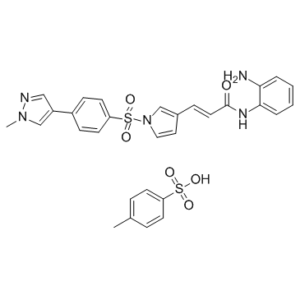Domatinostat (formerly known as 4SC-202) is a novel class I HDAC inhibitor (HDACi) that potently inhibited survival and proliferation of primary human colon cancer cells and established CRC lines (HT-29, HCT-116, HT-15, and DLD-1). It has IC50 values of 1.20 μM, 1.12 μM, and 0.57 μM for HDAC1, HDAC2, and HDAC3, respectively. Additionally, dominatinostat exhibits inhibitory activity against LSD1, or lysine specific demethylase 1. CRC cells were exposed to 4SC-202, which induced apoptosis activation; however, the cytotoxicity of 4SC-202 was considerably reduced in CRC cells by caspase inhibitors (z-VAD-CHO and z-DVED-CHO). Concurrently, 4SC-202 caused a significant G2-M arrest in CRC cells. AKT activation may be a significant resistance factor for 4SC-202, according to more research. The cytotoxicity of 4SC-202 was significantly enhanced in CRC cells by serum starvation, AKT inhibition (with perifosine or MK-2206), or AKT1-shRNA knockdown. Conversely, in HT-29 cells, constitutively active AKT1 (CA-AKT1) expressed exogenously reduced sensitivity by 4SC-202. Notably, 4SC-202 increased in vitro anti-CRC activity induced by oxaliplatin at a low concentration. We demonstrated that oral gavage of 4SC-202 inhibited HT-29 xenograft growth in nude mice in vivo, and that its activity was enhanced when combined with oxaliplatin. All of these pre-clinical findings suggest that 4SC-202 could be a worthwhile anti-CRC medication and chemoadjuvant that is worth more research.
Physicochemical Properties
| Molecular Formula | C₃₀H₂₉N₅O₆S₂ | |
| Molecular Weight | 619.71 | |
| Exact Mass | 619.155 | |
| CAS # | 1186222-89-8 | |
| Related CAS # |
|
|
| Appearance | Light yellow to brown solid powder | |
| LogP | 7.417 | |
| SMILES | CN1C=C(C=N1)C2=CC=C(C=C2)S(=O)(=O)N3C=CC(=C3)/C=C/C(=O)NC4=CC=CC=C4N |
|
| InChi Key | IAVXAZDVNICKFJ-ICSBZGNSSA-N | |
| InChi Code | InChI=1S/C23H21N5O3S.C7H8O3S/c1-27-16-19(14-25-27)18-7-9-20(10-8-18)32(30,31)28-13-12-17(15-28)6-11-23(29)26-22-5-3-2-4-21(22)24;1-6-2-4-7(5-3-6)11(8,9)10/h2-16H,24H2,1H3,(H,26,29);2-5H,1H3,(H,8,9,10)/b11-6+; | |
| Chemical Name | (E)-N-(2-aminophenyl)-3-[1-[4-(1-methylpyrazol-4-yl)phenyl]sulfonylpyrrol-3-yl]prop-2-enamide;4-methylbenzenesulfonic acid | |
| Synonyms |
|
|
| HS Tariff Code | 2934.99.9001 | |
| Storage |
Powder-20°C 3 years 4°C 2 years In solvent -80°C 6 months -20°C 1 month Note: Please store this product in a sealed and protected environment, avoid exposure to moisture. |
|
| Shipping Condition | Room temperature (This product is stable at ambient temperature for a few days during ordinary shipping and time spent in Customs) |
Biological Activity
| Targets | HDAC-3 ( IC50 = 0.57 μM ); HDAC-2 ( IC50 = 1.12 μM ); HDAC-1 ( IC50 = 1.2 μM ); HDAC-11 ( IC50 = 9.7 μM ); HDAC-5 ( IC50 = 11.3 μM ); HDAC-10 ( IC50 = 21 μM ); HDAC-9 ( IC50 = 50 μM ) |
| ln Vitro | Domatinostat tosylate suppresses clonogenic growth, induces caspase activity, and dramatically decreases the proliferation of all epithelial and mesenchymal UC cell lines (IC50 0.15-0.51 μM)[1]. In colorectal cancer (CRC) cells, domatinostat tosylate activates apoptosis, but caspase inhibitors (z-VAD-CHO and z-DVED-CHO) dramatically reduce the cytotoxicity that domatinostat tosylate causes in CRC cells. In the meantime, CRC cells experience a sharp G2-M arrest due to domatinostat tosylate. Additional research indicates that AKT activation may be a significant Domatinostat tosylate resistance factor. The cytotoxicity of domatinostat tosylate is significantly enhanced in colorectal cancer cells by serum starvation, AKT inhibition (with perifosine or MK-2206), or AKT1-shRNA knockdown. In contrast, constitutively active AKT1 (CA-AKT1) expressed exogenously reduces the HT-29 cells' sensitivity to dometinostat tosylate. Notably, oxaliplatin-induced in vitro anti-CRC activity is enhanced by domatinostat tosylate at low concentrations[2]. Strong cytotoxic and proliferation-inhibitory effects are induced against patient-derived primary HCC cells as well as established HCC cell lines (HepG2, HepB3, SMMC-7721) by domatinosal tosylate treatment. Apoptosis signal-regulating kinase 1 (ASK1) is activated by domatinostat tosylate, which results in its translocation to mitochondria and physical association with Cyp-D[3]. |
| ln Vivo | Domatinostat tosylate, when administered orally, inhibits the growth of HT-29 xenografts in nude mice. This effect is enhanced when oxaliplatin is added[2]. |
| References |
[1]. Evaluation of the Therapeutic Potential of the Novel Isotype Specific HDAC Inhibitor 4SC-202 in Urothelial Carcinoma Cell Lines. Target Oncol. 2016 Dec;11(6):783-798. [2]. Preclinical characterization of 4SC-202, a noval isotype specific HDAC inhibitor. [3]. Pre-clinical characterization of 4SC-202, a novel class I HDAC inhibitor, against colorectal cancer cells. Tumour Biol. 2016 Aug;37(8):10257-67. [4]. 4SC-202 activates ASK1-dependent mitochondrial apoptosis pathway to inhibit hepatocellular carcinoma cells. Biochem Biophys Res Commun. 2016 Mar 4;471(2):267-73. |
Solubility Data
| Solubility (In Vitro) |
|
|||
| Solubility (In Vivo) |
Solubility in Formulation 1: ≥ 2.5 mg/mL (4.03 mM) (saturation unknown) in 10% DMSO + 40% PEG300 + 5% Tween80 + 45% Saline (add these co-solvents sequentially from left to right, and one by one), clear solution. For example, if 1 mL of working solution is to be prepared, you can add 100 μL of 25.0 mg/mL clear DMSO stock solution to 400 μL PEG300 and mix evenly; then add 50 μL Tween-80 to the above solution and mix evenly; then add 450 μL normal saline to adjust the volume to 1 mL. Preparation of saline: Dissolve 0.9 g of sodium chloride in 100 mL ddH₂ O to obtain a clear solution. Solubility in Formulation 2: ≥ 2.5 mg/mL (4.03 mM) (saturation unknown) in 10% DMSO + 90% (20% SBE-β-CD in Saline) (add these co-solvents sequentially from left to right, and one by one), clear solution. For example, if 1 mL of working solution is to be prepared, you can add 100 μL of 25.0 mg/mL clear DMSO stock solution to 900 μL of 20% SBE-β-CD physiological saline solution and mix evenly. Preparation of 20% SBE-β-CD in Saline (4°C,1 week): Dissolve 2 g SBE-β-CD in 10 mL saline to obtain a clear solution. (Please use freshly prepared in vivo formulations for optimal results.) |
| Preparing Stock Solutions | 1 mg | 5 mg | 10 mg | |
| 1 mM | 1.6137 mL | 8.0683 mL | 16.1366 mL | |
| 5 mM | 0.3227 mL | 1.6137 mL | 3.2273 mL | |
| 10 mM | 0.1614 mL | 0.8068 mL | 1.6137 mL |
